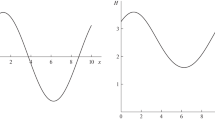Abstract
In this paper, a robust and efficient exponential multigrid framework is proposed for computing steady compressible flows. The algorithm based on a global coupling, exponential time integration scheme can provide strong damping effects to accelerate the convergence towards the steady state, while high-frequency, high-order spatial error modes are smoothed out with a \(s\)-stage preconditioned Runge–Kutta method. The resultant exponential multigrid framework is shown to be effective for smooth flows and can stabilize shock-capturing computations without limiting or adding artificial dissipation for medium-strength shock waves.
















Similar content being viewed by others
REFERENCES
B. Helenbrook, D. Mavriplis, and H. Atkins, “Analysis of p-multigrid for continuous and discontinuous finite element discretizations,” 16th AIAA Computational Fluid Dynamics Conference, AIAA-2003-3989 (2003).
B. T. Helenbrook and H. L. Atkins, “Application of p-multigrid to discontinuous Galerkin formulations of the Poisson equation,” AIAA J. 44 (3), 566–575 (2006).
K. J. Fidkowski, T. A. Oliver, J. Lu, et al., “p-multigrid solution of high-order discontinuous Galerkin discretizations of the compressible Navier–Stokes equations,” J. Comput. Phys. 207 (1), 92–113 (2005).
H. Atkins and B. Helenbrook, “Numerical evaluation of p-multigrid method for the solution of discontinuous Galerkin discretizations of diffusive equations,” 17th AIAA Computational Fluid Dynamics Conference (2005), p. 5110.
F. Bassi, N. Franchina, A. Ghidoni, et al., “Spectral p-multigrid discontinuous Galerkin solution of the Navier–Stokes equations,” Int. J. Numer. Methods Fluids 67 (11), 1540–1558 (2011).
S.-J. Li, Z. J. Wang, L. Ju, and L.-S. Luo, “Explicit large time stepping with a second-order exponential time integrator scheme for unsteady and steady flows,” 55th AIAA Aerospace Sciences Meeting, AIAA-2017-0753 (2017).
S.-J. Li, Z. J. Wang, L. Ju, and L.-S. Luo, “Fast time integration of Navier–Stokes equations with an exponential-integrator scheme,” 2018 AIAA Aerospace Sciences Meeting, AIAA-2018-0369 (2018).
S.-J. Li, L.-S. Luo, Z. J. Wang, and L. Ju, “An exponential time-integrator scheme for steady and unsteady inviscid flows,” J. Comput. Phys. 365, 206–225 (2018).
S.-J. Li, “Mesh curving and refinement based on cubic Bézier surface for high-order discontinuous Galerkin methods,” Comput. Math. Math. Phys. 59 (12), 2080–2092 (2019).
S.-J. Li, L. Ju, and S. Hang, “Adaptive exponential time integration of the Navier–Stokes equations,” AIAA-2020-2033 (2020).
M. Caliari and A. Ostermann, “Implementation of exponential Rosenbrock-type integrators,” Appl. Numer. Math. 59 (3), 568–582 (2009).
M. Tokman and J. Loffeld, “Efficient design of exponential-Krylov integrators for large scale computing,” Procedia Comput. Sci. 1 (1), 229–237 (2010).
Y. Saad, “Analysis of some Krylov subspace approximations to the matrix exponential operator,” SIAM J. Numer. Anal. 29 (1), 209–228 (1992).
C. Moler, “Nineteen dubious ways to compute the exponential of a matrix, twenty-five years later,” SIAM J. Numer. Anal. 45 (1), 3–49 (2003).
P. Roe, “Approximate Riemann solvers, parameter vectors, and difference schemes,” J. Comput. Phys. 43 (2), 357–372 (1981).
K. Kitamura and E. Shima, “Towards shock-stable and accurate hypersonic heating computations: A new pressure flux for AUSM-family schemes,” J. Comput. Phys. 245, 62–83 (2013).
N. Pierce and M. Giles, “Preconditioning compressible flow calculations on stretched meshes,” 34th Aerospace Sciences Meeting and Exhibit, AIAA-1996-889 (1996).
E. Toro, Riemann Solvers and Numerical Methods for Fluid Dynamics (Springer, Berlin, 1999).
Y. Saad, “GMRES: A generalized minimal residual algorithm for solving nonsymmetric linear systems,” SIAM J. Sci. Stat. Comput. 7 (3), 856–869 (1986).
P.-O. Persson and J. Peraire, “Sub-cell shock capturing for discontinuous Galerkin methods,” in The 44th AIAA Aerospace Sciences Meeting and Exhibit, AIAA-2006-112 (2006).
V. Schmitt and F. Charpin, “Pressure distributions on the ONERA-M6-wing at transonic Mach numbers, experimental data base for computer program assessment,” Report of the Fluid Dynamics Panel Working Group 04, AGARD-AR 138, May (1979).
ACKNOWLEDGMENTS
This work is funded by the National Natural Science Foundation of China (NSFC) under the Grant U1930402. Beijing Computational Science Research Center provides computing resources.
Author information
Authors and Affiliations
Corresponding author
Ethics declarations
The author declares that he has no conflicts of interest.
Rights and permissions
About this article
Cite this article
Li, SJ. Shock-Capturing Exponential Multigrid Methods for Steady Compressible Flows. Comput. Math. and Math. Phys. 62, 1397–1412 (2022). https://doi.org/10.1134/S0965542522080085
Received:
Revised:
Accepted:
Published:
Issue Date:
DOI: https://doi.org/10.1134/S0965542522080085




